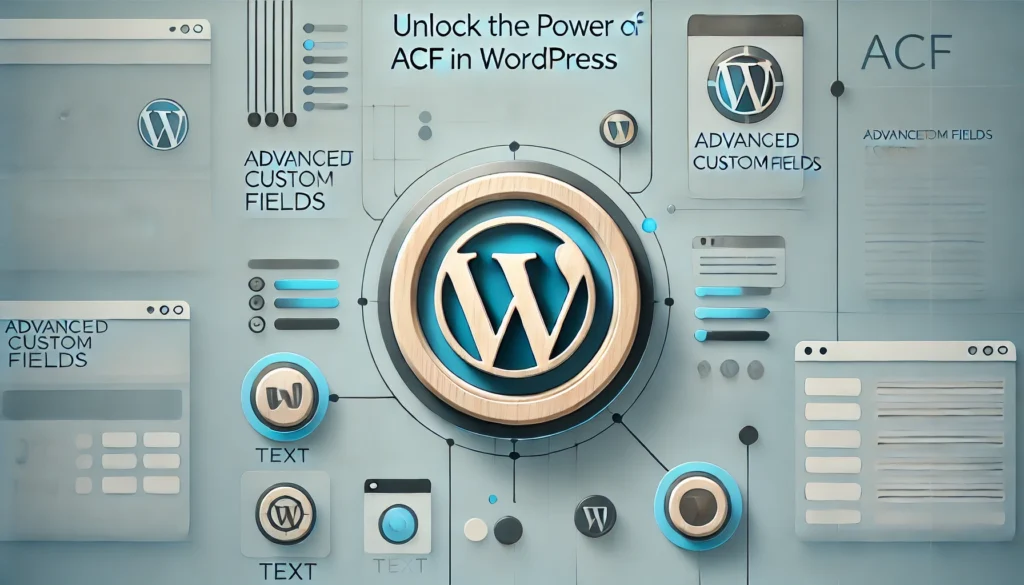WordPress has evolved far beyond just a blogging platform, transforming into a robust content management system (CMS) capable of handling complex websites. One of the tools that has significantly contributed to WordPress’s flexibility is the Advanced Custom Fields (ACF) plugin. ACF allows developers to add custom fields to their WordPress sites easily, extending its functionality without diving into extensive coding.
In this post, we’ll explore what ACF is, why it’s an essential tool for WordPress developers, how to use it effectively, and some advanced tips to make the most out of this powerful plugin.
What is Advanced Custom Fields (ACF)?
Advanced Custom Fields (ACF) is a WordPress plugin that simplifies the process of adding custom fields to your WordPress site. With ACF, you can add fields to posts, pages, custom post types, users, media, comments, and even options pages. The plugin provides a user-friendly interface where you can select the type of data you want to capture, making it easy to enhance your website’s structure and design.
Why Use ACF?
ACF allows developers to customize content structure, offering greater control over the data within a WordPress site. Here are some reasons why it’s widely used:
- Flexible Content Structure: ACF allows for the creation of unique content layouts that go beyond WordPress’s standard post types and taxonomies.
- No Coding Required for Basic Functionality: Even beginners can quickly add custom fields without needing to code.
- Enhanced User Experience: By using ACF, you can tailor the WordPress back-end to your client’s needs, streamlining their content management experience.
- Developer-Friendly: ACF offers extensive options for advanced customization, making it easy to manipulate data on the front end with PHP.
Getting Started with ACF
To start using ACF, install and activate the plugin from the WordPress Plugin Repository. Once installed, you’ll find the “Custom Fields” menu in your WordPress dashboard.
Step 1: Create a Field Group
A Field Group is a collection of custom fields that you want to apply to specific areas of your site. Here’s how to create one:
- Navigate to Custom Fields > Add New.
- Give your field group a name (e.g., “Project Details” if you’re creating a custom post type for a portfolio).
- Start adding individual fields to your group, choosing the type (such as text, image, or URL).
Step 2: Configure Field Settings
Each field has specific settings that define its behavior and appearance. Here’s a quick overview of some common field types:
- Text: Basic input for single lines of text.
- Textarea: A larger box for longer blocks of text.
- Image: An upload field for images.
- True/False: A simple checkbox field.
- Repeater: Allows you to add a set of fields multiple times (ideal for testimonials or team member sections).
Step 3: Set Location Rules
ACF provides a range of location rules to control where your fields appear. You can apply fields to posts, pages, custom post types, specific taxonomies, or even individual templates. This flexibility allows you to tailor the back-end precisely to your project’s needs.
Step 4: Display the Fields on Your Site
Once you’ve added fields and assigned location rules, you need to display the fields on the front end. This is typically done by editing your theme files. Here’s an example of how to retrieve and display a field in PHP:
<?php the_field('your_field_name'); ?>
If you’re familiar with the WordPress Loop, you can integrate ACF fields into your theme files wherever necessary.
Practical Use Cases for ACF
ACF’s versatility opens up endless possibilities for WordPress development. Here are some common use cases to get you inspired:
- Custom Post Types for Portfolios: Create fields like project date, client, project URL, and tools used to build a robust portfolio section.
- Team Member Profiles: Set up custom fields for each team member’s position, bio, and social media links.
- Dynamic Landing Pages: Use ACF to create flexible, easy-to-update landing pages with customizable text, images, and calls-to-action.
- Real Estate Listings: With ACF’s Repeater fields and field groups, you can set up complex listings with property details, agent info, and image galleries.
- Testimonials Section: Create fields for client name, quote, and client image to manage testimonials across your site.
Advanced Tips for Using ACF
If you’re ready to go beyond basic usage, these advanced tips can help you make the most of ACF’s capabilities.
1. Conditional Logic
ACF includes conditional logic, allowing fields to appear based on specific conditions. This is useful for managing complex forms where certain options should only appear if other fields are selected.
2. ACF Blocks for Gutenberg
ACF Pro includes a feature that enables you to create custom Gutenberg blocks. With this, you can design reusable, highly customized blocks for the WordPress editor, which is a game-changer if you’re building client sites or custom themes.
3. Options Pages
Options Pages allow you to create a global settings panel for your site. You can add fields like social media links, site-wide call-to-action messages, or footer details that you want accessible on every page.
4. Repeater Fields and Flexible Content
Repeater fields are invaluable for creating sections with repeated content, such as FAQs or multi-step processes. Flexible content, on the other hand, lets you build complex, modular layouts that can be rearranged on the fly.
5. ACF REST API Integration
If you’re working with headless WordPress, ACF’s REST API integration lets you retrieve custom field data via API endpoints. This feature is essential for projects where WordPress serves as a content hub, delivering data to a separate front-end framework (e.g., React or Vue).
Best Practices When Using ACF
- Plan Your Fields Carefully: Avoid adding unnecessary fields, as this can clutter the back end and impact site performance.
- Use Descriptive Field Names: Make your field names descriptive to keep your code readable, especially if others will work on the project.
- Limit Field Usage on Large Sites: While ACF is powerful, adding too many custom fields can slow down your site. Optimize queries and consider limiting field use in high-traffic areas.
- Regularly Update ACF Pro: If you’re using the Pro version, keep it updated to ensure you’re protected from potential vulnerabilities.
Advanced Custom Fields (ACF) is a must-have plugin for WordPress developers seeking to push the limits of what they can achieve with WordPress. Whether you’re building a portfolio site, a complex e-commerce store, or a content-rich blog, ACF provides the tools to manage and display custom data effortlessly.
With ACF, WordPress becomes more than just a CMS—it becomes a development platform capable of supporting unique and sophisticated web applications. By mastering ACF, you’ll not only streamline your workflow but also deliver a polished, user-friendly experience for your clients.
So why wait? Start experimenting with ACF on your next project and see the difference it makes!


